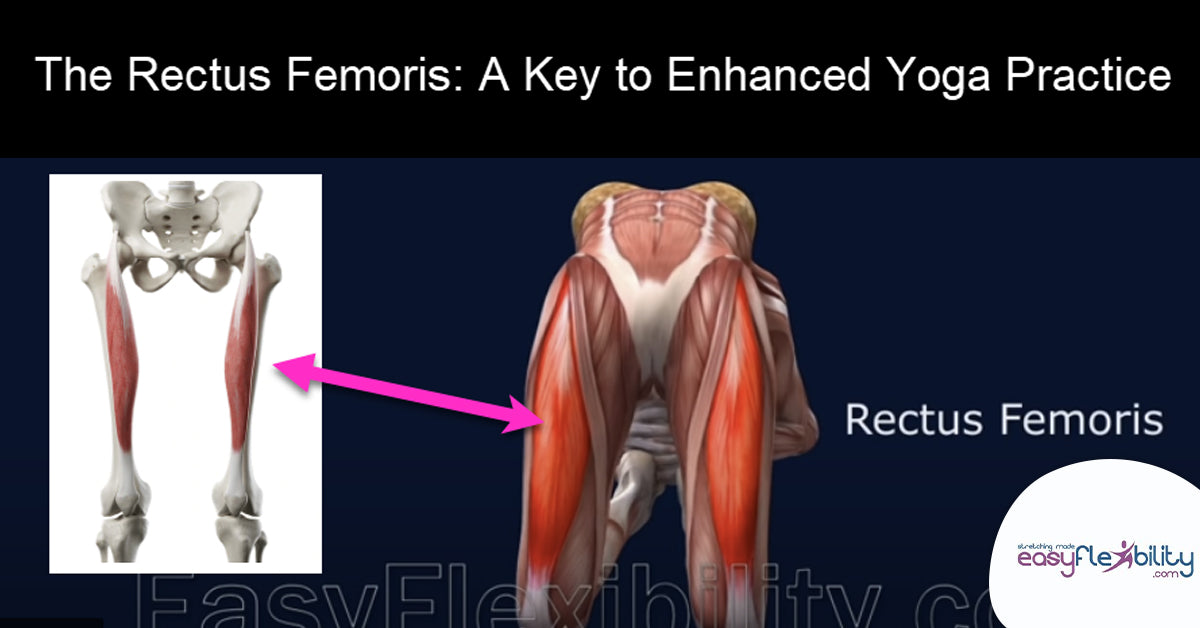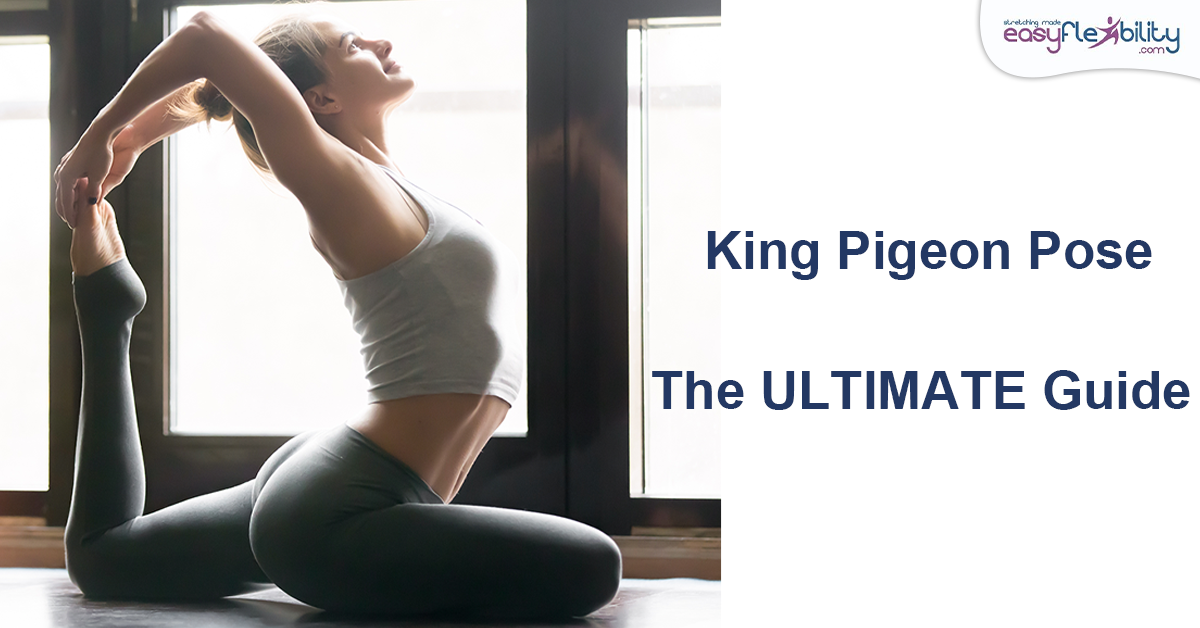From Anatomy to Asana: How Pectoralis Minor Influences Gormukhasana in Yoga
Posted by EasyFlexibility Team on

Unlocking the Secrets of Pectoralis Minor: Its Role in Yoga's Gomukhasana
When diving into the world of yoga, understanding the anatomy behind the poses can significantly enhance your practice, not just in execution but in the appreciation of each movement's impact on your body.
Today, we're spotlighting a lesser-known yet crucial muscle in the yoga anatomy landscape: the Pectoralis Minor. This muscle plays a pivotal role, especially in poses like Gomukhasana, also known as Cow Face Pose. Let's unravel the mysteries of the Pectoralis Minor—its anatomy, function, and its integral role in deepening your Gomukhasana experience.
- The Anatomy of Pectoralis Minor
- Pectoralis Minor in Action: Yoga Poses
- Pectoralis Minor and Gomukhasana: A Symbiotic Relationship
- Pectoralis Minor in Downward-Facing Dog
- Pectoralis Minor in High Plank (Phalakasana) Position
- Pectoralis Minor Muscle in Upward-Facing Dog
- Pectoralis Minor Syndrome: What it is? How does it feel like?
- Pectoralis Minor Stretch - ~Tranquility~ Zaichik Stretching Technique!
- The Emotional Link to Pectoralis Minor
-
Bridging Muscle and Energy: The Pectoralis Minor and the Heart Chakra
The Anatomy of Pectoralis Minor
Let's chat about a little muscle in your chest that doesn't always get the spotlight it deserves - the Pectoralis Minor. Picture this: it's like the quiet, hardworking sibling of the more famous Pectoralis Major, the muscle that bodybuilders love to show off. But trust us, the Pectoralis Minor is super important too. Let's dive in and get to know it better, shall we?

Nestled beneath its more famous counterpart, the Pectoralis Major, the Pectoralis Minor is a small yet mighty muscle that resides in the chest. Here's a closer look:
- Pectorals Minor Origin: This muscle originates from the third to fifth ribs, near the costal cartilages. Imagine the Pectoralis Minor as a plant. Its roots? They start from the third to the fifth ribs right near the costal cartilages - those are the parts that give your ribcage flexibility, kind of like the bendy part of a pair of glasses. This is where our little muscle buddy begins its journey.
- Pectorals Minor Insertion: Now, from its ribby roots, the Pectoralis Minor stretches up and attaches itself to a spot called the coracoid process of the scapula. Think of the scapula as your shoulder blade and the coracoid process as a little hook-like part where the muscle grabs on. It's like the muscle is reaching up to hold onto the edge of a cliff!
- Pectorals Minor Action: The primary actions of the Pectoralis Minor include scapular depression, protraction, and downward rotation. So, what does this muscle actually do? Well, it's got a few tricks up its sleeve. It helps pull your shoulder blade down and forward. Imagine shrugging your shoulders and then doing the opposite - that's scapular depression. Or think about reaching out to grab a cookie from the top shelf - that forward motion is protraction. And downward rotation? That's like giving a thumbs-down, but with your whole shoulder blade. Pretty cool, right?
- Pectorals Minor Nerve: It's innervated by the medial pectoral nerve (C8, T1), which signals it to spring into action. Every muscle needs a bit of a power-up to get going, and for the Pectoralis Minor, that power comes from the medial pectoral nerve (think of it as the muscle's personal trainer). This nerve, coming from parts of your neck and upper back (C8, T1, to be exact), is like the coach shouting, "Let's move!" And just like that, our muscle springs into action.
So there you have it - a quick tour of the Pectoralis Minor. It might not be the muscle that gets all the fame and glory, but it's doing a lot of the heavy lifting behind the scenes. Whether you're reaching, stretching, or just doing everyday tasks, give a little nod to the Pectoralis Minor for helping you out. It's the unsung hero of the chest muscles, making sure you can move your shoulders just the way you need to. Who knew something so small could be so mighty?
Pectoralis Minor in Action: Yoga Poses
The versatility of the Pectoralis Minor is showcased in several yoga poses, each engaging the muscle in different ways to achieve balance, strength, and flexibility.
Pectoralis Minor and Gomukhasana: A Symbiotic Relationship.
Gomukhasana, with its intricate arm binds and shoulder stretches, is a pose where the Pectoralis Minor is significantly engaged. Understanding how this muscle interacts with the pose can deepen your practice:
- Scapular Stability: The Pectoralis Minor is key to stabilizing the scapula, which is essential in achieving the arm position in Gomukhasana. This stability allows for a deeper stretch in the shoulders and arms.
- Enhanced Flexibility: Regular engagement and stretching of the Pectoralis Minor can lead to improved flexibility in the chest and shoulder region, making the arm bind in Gomukhasana more accessible.
- Injury Prevention: By understanding the role of the Pectoralis Minor, practitioners can be mindful of their limits, reducing the risk of straining this muscle during the pose.
Tips for Engaging Pectoralis Minor in Gomukhasana
- Warm-Up: Begin with gentle shoulder and chest stretches to prepare the Pectoralis Minor for the pose.
- Mindful Engagement: As you enter Gomukhasana, focus on the sensation in your chest and shoulders, ensuring you're engaging the Pectoralis Minor without straining it.
- Breath Work: Use your breath to deepen the stretch gently. Inhale to prepare, and exhale as you gently deepen the pose, allowing the Pectoralis Minor to stretch and release tension.

Unlock the secrets to mastering the Cow Face or Cow Head Pose faster than ever before with the revolutionary EasyFlexibility Cow Face or Cow Head Pose Gomukhasana Program!
Traditional yoga methods can drag on, struggling to stretch multiple muscle groups at once. But our program changes the game by zeroing in on each muscle with the cutting-edge Zaichik Stretching Techniques. Say goodbye to the frustration of slow progress and hello to a pain-free, rapid, and safe journey to flexibility.
Imagine achieving the perfect Cow Face or Cow Head Pose with ease, and seeing visible improvements in just 1 to 3 dynamic sessions. Our program is designed to bypass the common stretch reflex, catapulting you towards fast progress and lasting results. It's not just about flexibility; it's about building strength, too, making it perfect for yogis of all ages.
Dive into our focused 30 – 40 minute workouts, just 2 – 3 times a week, and experience the convenience of training at home, on your schedule, and on any device. With instant lifetime access, there are no hidden fees, no strings attached, just a clear path to success.
Get ready to transform your practice, elevate your flexibility, and achieve the Cow Face or Cow Head Pose with confidence and ease. Join us now and be part of a community discovering the smarter, faster, and safer way to flexibility and strength. Welcome to the future of your yoga journey!

Pectoralis Minor in Downward-Facing Dog (Adho Mukha Svanasana) Position in Yoga
Picture this: you're in Downward-Facing Dog, stretching out like a happy pup waking up from a nap. This pose is like a full-body hello, but it's also a secret handshake for the Pectoralis Minor. As you press your hands into the mat and lift your hips up and back, your shoulder blades naturally move apart. This action? It's all thanks to the Pectoralis Minor working hard, helping to stabilize and move your shoulders. It's like it's saying, "I've got you," ensuring you get that delicious stretch all through your back and shoulders.

Pectoralis Minor Muscle in High Plank (Phalakasana) Position in Yoga
Now, let's talk High Plank. It's not just a powerhouse move for your core; it's also a party for the Pectoralis Minor. When you're holding yourself up, every part of your body engaged and strong, your Pectoralis Minor is like the quiet friend who makes sure everything runs smoothly. It helps keep your shoulders just right, not too high, not too low, but perfectly in line. It's the muscle that's whispering, "You can do this," helping you hold that plank just a bit longer.

Pectoralis Minor Muscle in Upward-Facing Dog (Urdhva Mukha Svanasana) Position in Yoga
Transitioning into Upward-Facing Dog, you're opening your heart to the sky, feeling that glorious stretch across your chest. Here, the Pectoralis Minor is in its element, helping to lift and open your chest. It's working in harmony with your other muscles, making sure your shoulders don't just scrunch up to your ears. Instead, it's like it's gently pulling them down, creating space and freedom in your upper body. It's the Pectoralis Minor's way of saying, "Let's open up and embrace the world."

Pectoralis Minor Syndrome: What is it? How does it feel like?
Pectoralis Minor Syndrome sounds pretty technical, right? But here's the scoop in simpler terms: it's when the pectoralis minor muscle, which is this little muscle under the bigger chest muscle, gets too tight, overworked, or just plain stressed out. This can happen to anyone, but it's especially common if you're doing a lot of repetitive arm movements or if your job or sport keeps your shoulders in the same position for too long. For folks into health and fitness, keeping an eye out for this is key to staying on top of your game.
So, what does it feel like? Well, it can range from a nagging pain in your chest, shoulder, and arm to feeling numbness or even a weird tingling that shoots down to your fingers. And if you've ever tried to ignore pain and push through a workout, you know it doesn't usually end well. These symptoms can really throw a wrench in your daily routine and make your favorite activities feel like a chore.
Dealing with it isn't as daunting as it might seem. The game plan usually involves taking it easy for a bit, maybe seeing a physical therapist, and working on some specific stretches and exercises that target the pectoralis minor muscle. Massage therapy or myofascial release can also work wonders for loosening things up. Plus, focusing on staying flexible and improving your posture can go a long way in keeping this syndrome at bay.
In a nutshell, Pectoralis Minor Syndrome is a reminder of how important balance is in our bodies. Paying attention to the signs and taking steps to manage it can help you keep doing what you love, pain-free. It's all about taking good care of that muscle and, by extension, your overall physical health.
Pectoralis Minor Stretch - ~Tranquility~ Zaichik Stretching Technique!
Discover a unique Zaichik Stretching Technique within our EasyFlexibility program tailored for Shoulder Flexion. This particular ZST targets your pectoralis minor, ensuring it remains supple and flexible. If you're new to Zaichik Stretching Techniques, prepare for a groundbreaking experience.
Crafted by the globally acclaimed fitness and flexibility guru Paul Zaichik, who brings over three decades of expertise to the table, this method stands out by isolating each muscle individually, guaranteeing they fulfill their intended role. It prioritizes the tighter muscles, allowing for a more focused and efficient stretching experience.
What sets this method apart is its solo-friendly design. You won't need to push, bounce, or have a partner to assist you. And forget the old adage "No Pain - No Gain." Our stretches are designed to be completely pain-free, removing any discomfort and making your training sessions more productive and enjoyable.
Safety is at the core of our approach, aligning with your body's natural movements to ensure a risk-free practice. The benefits of this method are not only immediate but also permanent and progressively enjoyable.
Our program diverges from traditional stretching techniques, which often rely on other poses or asanas for preparation. Instead, Zaichik Stretching Techniques isolate each muscle for stretching, offering a pain-free, swift, and straightforward method that's both effective and secure.
You'll see visible results quickly, thanks to our method's ability to bypass the stretch reflex, allowing you to showcase your newfound flexibility sooner than you might expect!
To Preform the ~Tranquility~ ZST:
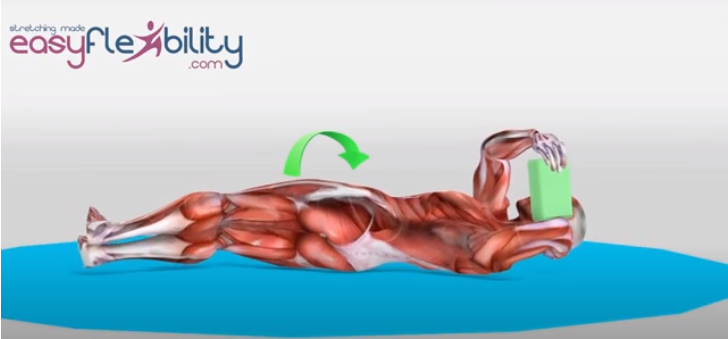
• Place one hand behind the head.
• Take one yoga block and place it on the inside of the upper arm.
• Turn your body away until the elbow comes off the floor.
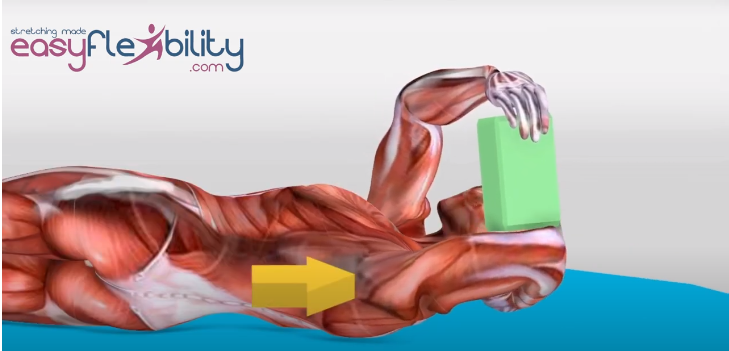
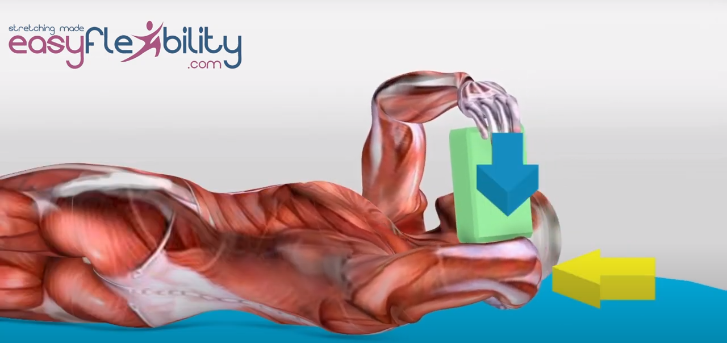
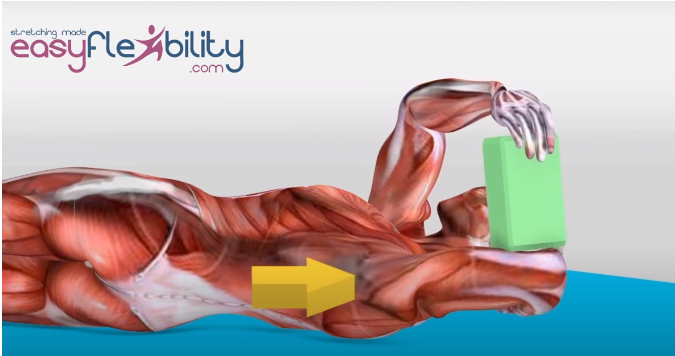
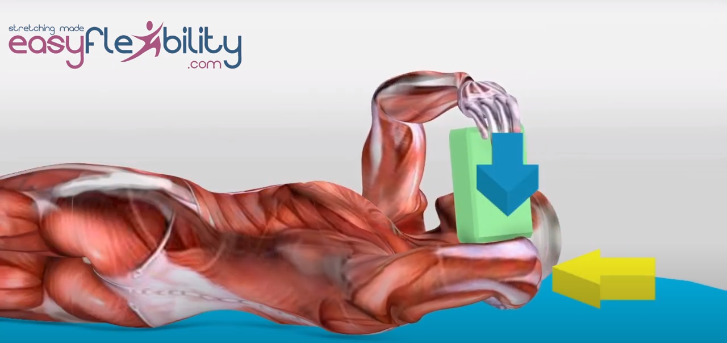
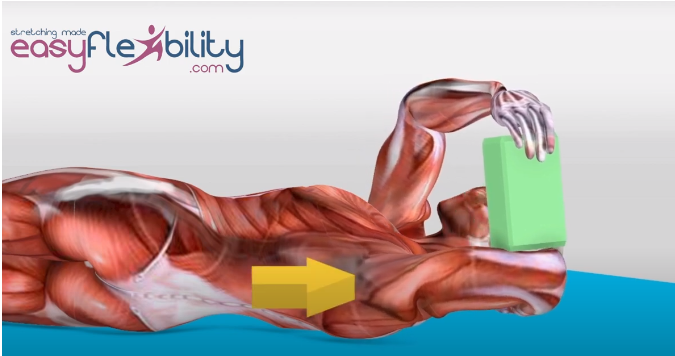
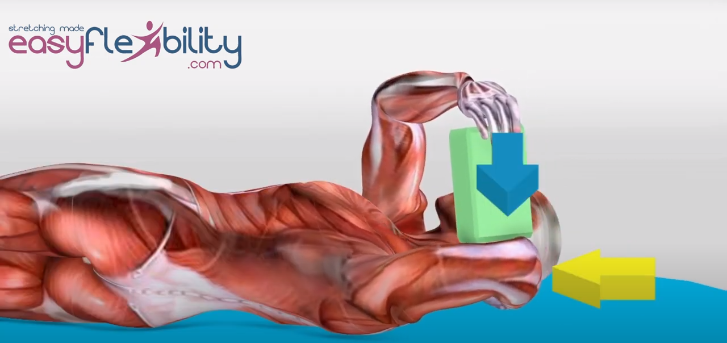
Dive into a world of effortless overhead shoulder flexibility with our revolutionary program!
Say goodbye to outdated, painful stretching methods and hello to the Zaichik Stretching Techniques—a game-changer in achieving swift and noticeable flexibility gains.
Imagine feeling a remarkable difference in just 1 to 3 sessions, all through a safe, pain-free approach tailored for every age.
Our program is not just about stretching; it's a fusion of flexibility and strength, designed to fit seamlessly into your life.
Spend just 30 – 40 minutes, 2 – 3 times a week, and unlock the door to lasting shoulder mobility and strength.
Plus, with instant lifetime access to our dynamic, easy-to-follow sessions—available anytime, anywhere, on any device—you're all set for a journey to peak shoulder flexibility without the fear of pain or injury.
Get ready to transform your flexibility and elevate your health and fitness journey with us!

The Emotional Link to Pectoralis Minor
In the realm of health and fitness, particularly within certain holistic and alternative practices, it's believed that various muscles and areas of the body can be linked to emotional states.
The pectoralis minor, a muscle located in the chest, is sometimes associated with emotions related to stress, anxiety, and the feeling of being emotionally closed off or protective of oneself. This perspective stems from the idea that stress and emotional burdens can lead to physical tension in the body, including areas like the chest.
The pectoralis minor, that small yet significant muscle nestled within the chest, serves as a prime example of this connection. It's interesting to think about how this muscle, often overlooked in discussions about major muscle groups, could be holding onto more than just physical tension—it might also be a reservoir for emotional stress.
The idea is that emotions related to stress, anxiety, and feelings of being emotionally guarded or protective, can manifest physically in this area. This muscle, then, becomes a sort of emotional storage space, holding onto the burdens we're not even aware we're carrying.

Bridging Muscle and Energy: The Pectoralis Minor and the Heart Chakra
While the pectoralis minor is not traditionally linked to the chakra system, its anatomical position and function suggest a symbolic and energetic connection to the Heart Chakra. Here's how:
Proximity to the Heart: The pectoralis minor's location in the chest, near the heart, aligns it with the Heart Chakra's physical domain. This proximity suggests that tension in the pectoralis minor could impact the flow of energy through the Heart Chakra, potentially affecting emotional and spiritual well-being.
Influence on Breathing: Given its role in the mechanics of breathing, the pectoralis minor can affect the depth and quality of breath. Deep, full breaths are essential for opening and balancing the Heart Chakra, indicating that a relaxed and well-functioning pectoralis minor is conducive to a harmonious energy flow.
Emotional Storage: Just as the Heart Chakra is associated with emotional aspects such as love and compassion, muscles, including the pectoralis minor, are often considered to store emotional tension. Releasing physical tension in this muscle could, therefore, facilitate emotional release and healing in the realm of the Heart Chakra.

In conclusion the Pectoralis Minor may be small, but its impact on poses like Gomukhasana is profound. By understanding and respecting this muscle's role in your yoga practice, you can achieve a deeper, more fulfilling experience in your poses. Remember, yoga is a journey of discovery—both of the self and the intricate anatomy that supports us. Embrace this journey with curiosity and openness, and watch as your practice transforms.
The essence of yoga transcends the mere perfection of poses; it's a voyage of self-discovery, exploring the depths of movement, and unveiling the intricate connections within our bodies. To truly embrace the richness of yoga, achieving ease and comfort in each asana enhances the experience, making it more fulfilling. This is where EasyFlexibility's online on-demand video training programs shine, offering a unique approach to mastering yoga poses.
EasyFlexibility takes a meticulous approach to yoga, with specialized programs tailored to individual asanas. By focusing on the specific muscles involved in each pose, our system ensures a comprehensive and effective flexibility training. This targeted method not only aids in achieving the desired flexibility but also ensures the process is safe, fast, and accessible.
Our extensive collection includes 18 yoga programs, each designed with precision to cater to different needs and goals. Whether you're looking to deepen your practice, overcome limitations, or simply enjoy yoga without the strain, EasyFlexibility provides the tools and guidance necessary to enhance your journey. With our on-demand video training, you have the freedom to progress at your own pace, in the comfort of your home, ensuring a personalized and convenient yoga experience.
Embrace the full potential of your yoga practice with EasyFlexibility, where flexibility and strength meet ease and efficiency. Let us guide you to a more enjoyable, fulfilling, and comprehensive yoga experience, where every pose is within reach, and the journey of discovery is enriched by the freedom of movement.
Unlock the Secret to Supreme Flexibility with EasyFlexibility's Ultimate Yoga Collection!
Dive into a world where flexibility knows no bounds, and your body discovers movements you never thought possible. With EasyFlexibility's Ultimate Yoga Collection, you're not just purchasing a program; you're unlocking the door to a temple of transformation. Here's what's waiting for you on the other side:
🌟 **Access to 19 Revolutionary Yoga Training Programs:** From the elegance of the Butterfly to the strength of the Hand Stand, journey through over 200 unique exercises designed for your whole body. Each program, from the Downward Facing Dog to the majestic King Pigeon Pose, is your stepping stone to unparalleled flexibility and strength.
🎥 **Over 9 Hours of Immersive Yoga Video Lessons:** Let our EasyFlexibility founder Paul Zaichik guide you through each movement with over 9 hours of detailed video lessons. Watch, learn, and practice at your own pace, in the comfort of your home.
🌍 **Join a Thriving Community of thousands of Practitioners and Instructors:** You're never alone on your flexibility journey. With unlimited lifetime access to our vibrant community, find the support, motivation, and personalized coaching you need to reach your goals. Share your progress, ask for tips, and connect with fellow flexibility enthusiasts.
Whether you're aiming to perfect your Plow Pose or master the Eka Pada Sirsasana, EasyFlexibility's Ultimate Yoga Collection is your all-in-one ticket to a more flexible, stronger, and healthier you. Say goodbye to stiffness and hello to a life where every movement is effortless.
Ready to transform your body and mind? Join us now and bend the rules of what's possible. Your ultimate flexibility journey begins here.
Share this post
- Tags: cow face pose, gomukhasana, pectoralis minor, pectoralis minor chakra, pectoralis minor emotions, pectoralis minor muscle stretch, pectoralis minor stretch, pectoralis minor syndrome




